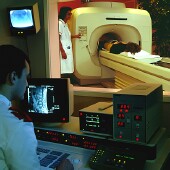
WEDNESDAY, Feb. 17 (HealthDay News) — Surging use of improved medical technology, including new drugs, is driving up life expectancy for Americans and driving down rates of major killers such as heart disease and cancer, a new national health report finds.
At the same time, some things about the nation’s health that experts hoped were changing actually did not, the report found, and the use and misuse of medical technology may also be a factor behind the ever-increasing cost of health care.
The findings are included in a report, entitled “Health, United States, 2009,” issued Wednesday by the U.S. National Center for Health Statistics, part of the Centers for Disease Control and Prevention.
Although Americans are living longer than ever before — 77.9 years on average — “a lot of things that should have been changing aren’t really changing that much,” said Amy B. Bernstein, chief of the Analytic Studies Branch in the Office of Analysis and Epidemiology at the U.S. National Center for Health Statistics.
“Cigarette smoking has pretty much leveled off,” she said. “There is still 20 percent of the population that smokes; that’s bad. People are not exercising more. Obesity is not decreasing.”
Obesity has doubled over the past three decades, from 15 percent of adults in 1976 to 35 percent by 2006, according to the report. As of 2006, 15 to 18 percent of school-age children and adolescents were overweight.
These are things that should be changing and need to be worked on, Bernstein said.
The annual report on the nation’s health also found that:
- Heart disease, cancer and stroke, in that order, remain the three leading causes of death in the United States, although deaths attributed to all three have declined.
- About 10 percent of Americans rate their health as only “fair or poor,” an increase since the last report.
- Americans’ use of medications has tripled, with 47 percent of U.S. residents now taking at least one prescription drug. Half of adults older than 45 take diabetes medications, and 10 times as many people took cholesterol-lowering drugs from 2003 to 2006 as took the drugs from 1988 to 1994.
- More Americans are going without health insurance, with almost 8 percent of those aged 18 to 64 uninsured, according to the report, based on data collected in 2007, before the worst of the current economic crunch set in.
Nonetheless, Americans are living longer, which might be due in large part to the ever-increasing use of medical technology.
“Technology is really what’s driving our medical care system,” Bernstein said. The report found, for instance, that the rate of magnetic resonance imaging (MRI) scans and computed and positron emission tomography (CT/PET) scans tripled from 1996 to 2007.
Knee replacements, the report found, increased 70 percent in the past decade. And organ transplants also became more common. The number of kidney transplants per 1 million people increased 31 percent, for example, and the number of liver transplants increased 42 percent.
But, all of this technology comes at a price, Bernstein said. “Once a technology is introduced, it seems to have a life of its own,” she said. “Once you start using it, it is hard to stop using it — even if there are reasons that you should.”
As an example, she cited the use of drug-eluting stents, which were highly touted as better than bare-metal stents, used to keep arteries open. However, Bernstein said, new research indicates that they may not benefit everyone.
“There is no doubt that technology can improve life and save life,” she said. “But the question is: ‘Do you need to do everything to everyone?'”
The increased use of technology also raises ethical questions, Bernstein said. For example, the report found a dramatic increase in the use of mechanical ventilation to keep people alive.
“There is no way we can say it’s a good thing or a bad thing,” she said. “It’s clearly a good thing for the people it saved. The question then is: ‘Is it a good thing for the people who aren’t saved?'”
Bernstein said she believes that the use of technology will continue to increase.
That, however, can have a downside, explained Dr. David L. Katz, director of the Prevention Research Center at Yale School of Public Health.
“Age-adjusted mortality rates in the U.S. have been falling steadily over recent years, and life expectancy has been increasing. Advances in medical technology and pharmacotherapy are important reasons for these favorable trends,” Katz said.
“But the rise in use of high-tech scans, such as MRI and PET, and the rise in related health-care costs far exceed any measurable health benefits that may be related,” he noted.
“In other words, the bucks are clearly adding up a lot faster than the bang,” Katz said.
Compounding this concern, he said, is the fact that though medical technology can help stave off death, it does far less to preserve or establish vitality.
“Trends for death rates are favorable, while disability trends are neutral, and trends for the total population burden of obesity and chronic disease are decidedly adverse,” Katz said. “The more societal resources we allocate to medical technology, the less we may devote to supporting the lifestyle practices that can actually build health at its origins.”
In an age of evidence-based medicine and unsustainable health-care costs, Katz said, advanced medical technology cannot be “toys with which we play just because we have them.”
More information
To see the full report, go to the U.S. National Center for Health Statistics.

